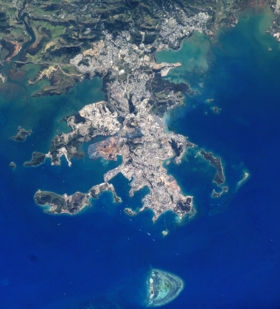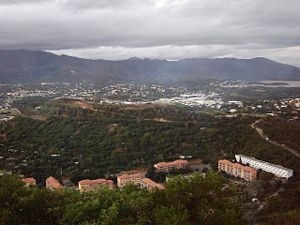|
|
|
|
|
|
|
|
|
|
|
|
NouméaNew Caledonia - Melanesia - Pacific Ocean
Nouméa is the capital city of the French territory of New Caledonia. It is situated on a peninsula in the south of New Caledonia's main island, Grande Terre, and is home to the majority of the island's European, Polynesian (Wallisians, Futunians, Tahitians), Indonesian, and Vietnamese population, as well as many Melanesian Ni-Vanuatu and Kanaks that work in one of the South Pacific's most industrialised cities. The city lies on a protected deepwater harbour which serves as the chief port for New Caledonia. The population of the city (commune) at the Aug./Sept. 2004 census was 91,386 inhabitants (up from 76,293 inhabitants at the 1996 census). Including the suburbs of Nouméa, the population of the Greater Nouméa metropolitan area (French: agglomération du Grand Nouméa) at the 2004 census was 146,245 inhabitants (up from 118,823 inhabitants in 1996, meaning a booming 2.5% population increase per year). 63.4% of the population of New Caledonia live in Greater Nouméa, which covers the communes of Nouméa, Le Mont-Dore, Dumbéa and Païta.
History The area in which the city is found was not an important one for Kanaks prior to European settlement; the first European to set up a settlement nearby was a British trader, James Paddon, in 1851. The French, anxious to assert control of the island, established a settlement there three years later in 1854, originally named Port-de-France, (moving from the settlement of Balade in the north of the island). The area served first as a penal colony, later as a centre for the exploitation of the nickel and gold that was mined nearby. It served as the headquarters of the United States military in the Pacific during World War II. The U.S. military headquarters - a pentagonal complex - was, after the war, taken over as the base for a new regional intergovernmental development organisation: the South Pacific Commission. The Secretariat of the Pacific Community, as it was later known, has become a "mini-United Nations of the South Pacific" in the words of the former President of Vanuatu, Ati George Sokomanu, with the additional distinction of allowing island territories equal status and voting rights with independent countries in its governing council. Even today the U.S. wartime military influence lingers, both in the warmth that many New Caledonian people feel towards the United States after experiencing the relative friendliness of American soldiers, and also in the names of several of the quartiers in Nouméa. Districts such as "Receiving" and "Robinson", or even "Motor Pool", strike the anglophone ear strangely, until the historical context becomes clear.  Orbital photo of Nouméa and suburbs, taken from the International Space Station. Courtesy of NASA & Wikipedia. Nouméa, the city, is the most "westernised" in the Pacific Islands region, with the exception of Hagåtña, Guam, and is a complete contrast to the rest of New Caledonia's wide open spaces, bare jagged hills, and largely Kanak population (although there also exist important concentrations of Europeans on the northwestern coast of New Caledonia's mainland, particularly around Bourail, Pouembout, and Koumac). Although Nouméa probably has the "best" climate in the South Pacific, with more sunshine days than any other Pacific Island capital, and some excellent beaches not far from the city centre, it is not currently a major tourist destination. The cost of living is high, and there is no cheap air-travel from the Pacific Rim. Nouméa's international airport is at Tontouta, the La Tontouta International Airport, 50 kilometres from the city, although there is an airport within the city, Magenta, which services local routes. Nouméa is, as of 2007, one of the most rapidly-growing cities in the Pacific, and has experienced a major housing construction boom within the past decade. The installation of amenities has kept pace, and the municipality boasts a public works programme.  Noumea looking north showing new housing, 2006 It is the hope of the government that this investment, over the lifetime of the multi-decadal track towards increasing autonomy planned under the Matignon Agreements and now the Nouméa Accord, will eventually become fully sustainable. (Amongst the Francophone development intelligentsia there is some criticism of the way in which the British withdrew so rapidly from their colonies in Asia, Africa and the Pacific, without first ensuring the sustainability of the new nations)
All text is available under the terms of the GNU Free Documentation License (see Copyrights for details). About Wikipedia Disclaimers
This information was correct in July 2008. E. & O.E.
2008
Site Index Back to Top Photos Index Thanks for coming, I hope you
have enjoyed it, will recommend
it to your friends, and will come
back later to see my site developing
and expanding.
|
||||||||||||||||||||||||||||||||||||||||||||||||||||||||||||||||||||||||||||||||||||||||||||||||||||||||||||||||||||||||||||||||||||||||||||||||||||||||||||||||||||||||||||||||||||||||||||||||||||||||||||||||||||||||||||||||||||||||||||||||||